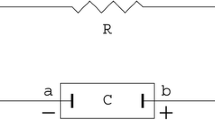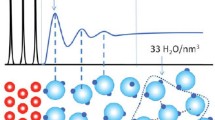Abstract
Chemical reactions between “far-away” components are quite common in the living world and in geological processes, and are affected by communicating shuttling molecules and ions. Surprisingly, there has been little attention in the chemical literature to model these natural processes by bench-laboratory heterogeneous reactions. Towards that goal we report the study of chemical communication between solid acids and bases placed at distance. The porous solids were prepared by entrapping various acids and bases in silica sol-gel matrices. We recall that while, of course, dissolved acids and bases titrate each other, when solid acids and bases are placed in the same pot, titration can be affected only through an ion-exchange process. This property is used here to cause the two distantly placed solids to communicate with each other. In particular, we use here the entrapped acids as senders of messenger-hydronium ions and as receivers of hydroxyl ions, and entrapped bases as senders of messenger-hydroxyls. We demonstrate the possibility to control the parameters of the communication between these solids.
Similar content being viewed by others
References
Hahn ME, Simmel EC (1976) Communicative behavior and evolution, Ch 2. Academic Press, New York, San Francisco, London, pp 23–37
Johnston JW, Moulton DG, Turk A (1970) Communication by chemical signals, vol. 1. Appleton-Century-Crofts, Meredith Corporation, New York, pp 108–111
Owings DH, Beecher MD, Thompson NS (1997) Perspectives in Ethology, Ch 1. Plenum Press, New York, pp 7–53
Elderfield H, Wheat CG, Mottl MJ, Monnin C, Spiro B (1999) Earth Planetary Sci Lett 172:151
Backstrom M, Karlsson S, Backman L, Folkeson L, Lind B (2004) Water Research 38:720
Schlegel ML, Manceau A, Chateigner D, Charlet L (1999) J Colloid Interface Sci 215:140
Fireman-Shoresh S, Hüsing N, Avnir D (2001) Langmuir 17:5958
Avnir D, Klein LC, Levy D, Shubert U, Wojcik AB (1998) In: Rappoport Z, Apeloig Y (eds) The chemistry of organosilicon compounds, Ch 40, vol. 2. Wiley & Sons, Chichester, pp 2317–2371
Levy D, Kuyavskaya BI, Zamir I, Ottolenghi M, Avnir D, Lev O (1992) Separat Sci Tech 27:589
Brinker JC, Scherer GW (1990) Sol-gel science: The physics and the chemistry of sol-gel processing, Ch 3. Academic Press, San Diego, pp 97–228
Hench LL, West JK (1990) Chem Rev 90(1):33
Gelman F, Blum J, Avnir D (2001) Angew Chem Int 40:3647
Gelman F, Blum J, Schumann H, Avnir D (2003) J Sol-Gel Sci Tech 26:43
The structures: a. Methyl red b. Bromocresol Purple, Bishop E (1972) Indicators, Pergamon Press Ltd., Headington Hill Hall, Oxford, pp 81–83, 106,
Harmer M, Farneth W, Sun Q (1996) J Am Chem Soc 118:7708
Rottman C, Grader G, De-Hazan Y, Malchior S, Avnir D (1999) J Am Chem Soc 121(37):8533
Hüsing N, Schubert U, Misof K, Fratzl P (1998) Chem Mater 10:3024
Hüsing N, Schubert U, Mezei R, Fratzl P, Riegel B, Kiefer W, Kohler D, Mader W (1999) Chem Mater 11:451
Gelman F, Blum J, Avnir D (2000) J Am Chem Soc 122:11999
The salts which were tested are: LiCl, NH4Cl, FeCl3×6H2O, KNO3, KIO3, KCl, NaI, NaBr, NiSO4, Na3C6H5O7×2H2O, CH3(CH2)11OSO3Na, CH3C6H4SO3Na, NH4CH3COO, K3Fe(CN)6, KSCN, NaNO3, NaCl, Li2SO4, K2SO4, KH2PO4, Na2HPO4, Li2CO3, NaIO3, MgSO4, Na2SO4
Kogan A, Avnir D (2003) Chemical communication between solids placed at distance, M.Sc. thesis, The Institute of Chemistry, The Hebrew University of Jerusalem, Israel
Koone ND, Zerda TW (1997) J Sol-Gel Sci Tech 8:883
Agmon N (1995) J Molec Liq 64:161
Robinson RA, Stokes RH (1959) Electrolyte solutions, 2nd edn. Butterworth & Co. Ltd., London, p 463
Author information
Authors and Affiliations
Corresponding author
Rights and permissions
About this article
Cite this article
Kogan, A., Avnir, D. Chemical communication between solids placed at distance: Sol-gel entrapped acids and bases. J Sol-Gel Sci Technol 40, 233–239 (2006). https://doi.org/10.1007/s10971-006-9207-8
Published:
Issue Date:
DOI: https://doi.org/10.1007/s10971-006-9207-8




